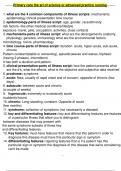Primary care the art of science or advanced practice nursing
1. what are the 4 common components of illness scripts: mechanisms
epidemiology clinical presentation time course
2. epidemiology-parts of illness script: age, gender, race/ethnicity
risk factors- like other medical conditions/lifestyle
exposure- travel, pets, occupation, activities, close contacts
3. mechanisms-parts of illness script: what are the derangement's anatomy,
physiology, genetics, immunology what are the environmental factors
microbiology, toxins, pharmacology
4. time course-parts of illness script: duration- acute, hyper-acute, sub-acute,
chronic
Pattern-constant(stable or worsening), episodic(waxes and wanes, biphasic
(having 2 phases), intermittent)
It has both a duration and pattern
5. clinical presentation-parts of illness script: how the patient presents what
are the s/s, what the effects, what is the objective and subjective data received
6. prodrome: symptoms
7. acute: New, usually of rapid onset and of concern, opposite of chronic (few
days)
8. subacute: between acute and chronic
(a couple of weeks)
9. hyperacute: extremely or excessively acute
(suddenly/hours)
10. chronic: Long-standing, constant. Opposite of acute
(few months)
11. syndrome: collection of symptoms (not necessarily a disease)
12. key and differentiating features: key and differentiating features are features
of a particular illness that allow you to distinguish
between diseases that may present with
the same syndrome subsets of these key
and differentiating features
13. Key features: must-have features that means that this patient in order to
diagnose this disease must have this particular sign or symptom
14. differentiating features: rejecting features that is if a patient has this
particular sign or symptom the diagnosis of this disease that we're considering
can't be made
1/7
, .
15. derangement: disturbance of normal bodily functioning
16. what are illness scripts: classic disease representations
17 In illness scripts, epidemiology refers to what: a description of what type of
person gets this disease
18. when thinking about clinical problem solving all of the following are true
except: the following statement is not true: experts organize data in the way
they were taught in medical school
True - they are constantly reorganizing data through out their career
19. when compared with novices, experts do what when it comes to
diagnosis and amout of data: make more accurate diagnosis with less data
20. determinants: any factor, whether event, characteristic, or other definable
entity, that brings about a change in a health condition or other defined
characteristic
21. what are the social determinants of health:
food education
environment/neighborhood
health care economic stability
social and community context
22. primary prevention: actions that keep the
disease process from/health condition from being
established in the first place
23. secondary prevention: aims at asymptomatic disease through screening and
testing
24. tertiary prevention: treatment for a person who is symptomatic and ill usually
by a medical professional
25. whats the focus of the medical model: •Focus on disease
•Diagnosis, treatment, response
26. whats the focus of the nursing model: •Focus on the experience of the
illness (the whole of the iceberg)
•Diagnosis, treatment, response
27. what the tip of the iceberg: the medical model
28. what are the elements of Nursing-Based Approach to Primary Care: -
Health promotion
2/7





